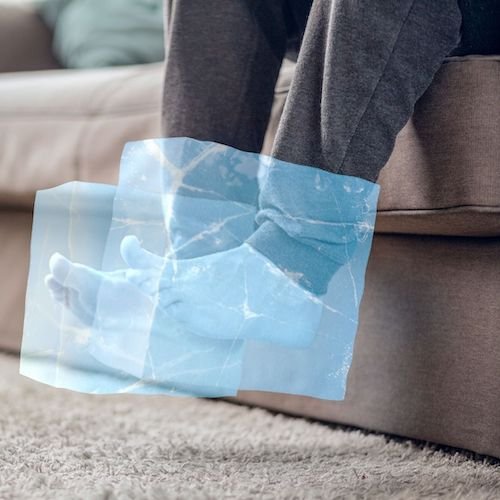Symptoms to Solutions: Peripheral Neuropathy
By Dr. Justin Griffin, D.C

What is Peripheral Neuropathy?
Neuropathy refers to damage or dysfunction of the peripheral nerves, which are responsible for transmitting signals between the central nervous system (the brain and spinal cord) and the rest of the body. Damage to these nerves can result in various symptoms, including numbness, tingling, muscle weakness, and pain, primarily affecting the hands and feet.
Causes of Peripheral Neuropathy:
While there are over 100 causes of neuropathy, it can be caused by a variety of factors including diabetes, which is one of the most common causes, leading to high blood sugar levels that damage nerves over time. Other causes include traumatic injuries, infections, metabolic problems, inherited causes, exposure to toxins, and many more.
Symptoms of Peripheral Neuropathy:
Common symptoms may include numbness and tingling in the hands and feet, often described as a "pins and needles" sensation. Many individuals experience sharp, burning, or throbbing pain, which may be constant or intermittent. Muscle weakness is another hallmark, potentially leading to difficulty in coordination and balance, increasing the risk of falls. Other symptoms may include muscle cramps, twitching, and a reduced ability to feel temperature changes or pain, which can result in unnoticed injuries. The severity and combination of symptoms can vary, and early diagnosis and management are crucial for improving quality of life.
What if I have balance problems?
Neuropathy, particularly peripheral neuropathy, significantly impacts balance by affecting the nerves that carry essential signals between the brain, muscles, and sensory systems in the feet and legs.
Loss of Sensation in the Feet: Neuropathy often causes numbness or reduced sensation in the feet and legs. This loss of feedback from the ground makes it harder for individuals to gauge their footing, leading to instability and a higher risk of falls.
Weakness in the Muscles: Neuropathy can weaken the muscles responsible for maintaining posture and supporting movement. This muscular weakness compromises coordination, further impairing balance.
Disrupted Proprioception: Proprioception is the body's ability to sense its position in space. When neuropathy damages sensory nerves, individuals struggle with spatial awareness, which is critical for maintaining balance while walking or standing.
Pain and Discomfort: Burning, tingling, or sharp pain from neuropathy can distract and destabilize individuals. Pain-induced hesitation or avoidance of certain movements can exacerbate balance issues.
Delayed Reflexes: Damaged nerves slow down reflex responses, making it difficult for the body to react quickly to changes in position or unexpected obstacles, increasing fall risk.
Impact on Autonomic Nerves: Neuropathy affecting autonomic nerves can alter blood pressure regulation, leading to dizziness or lightheadedness upon standing, known as orthostatic hypotension. This contributes to balance problems.
By understanding how neuropathy affects balance, targeted therapies can be implemented to restore nerve health, strengthen muscles, and improve proprioception. Early intervention not only enhances mobility but also significantly reduces the risk of falls and associated injuries, improving overall quality of life.
From Symptoms to Solutions: How our treatment protocols Help Nerve Function
Understanding the progression of neuropathy is crucial for appreciating the importance of early and effective treatment. The condition typically progresses through several phases, each with distinct symptoms and consequences if left untreated.
- Initial Evaluation:
A thorough evaluation is conducted to understand the patient's medical history, symptoms, and previous treatments. This helps in creating a tailored treatment plan.
- Stimulation of Angiogenesis:
Advanced medical technologies are used to stimulate angiogenesis. This process enhances blood flow to the affected nerves, ensuring they receive the necessary nutrients and oxygen. Techniques such as low-level laser therapy and other modalities may be employed to promote the formation of new blood vessels.
- Activation of Schwann Cells:
With improved blood flow, Schwann cells are activated to repair the damaged areas. These cells play a crucial role in regenerating the myelin sheath and axon, effectively restoring nerve function. The activation of Schwann cells is facilitated through a combination of multiple regenerative therapies.
- Ongoing Monitoring and Adjustment:
Throughout the therapy, the patient's progress is closely monitored. Adjustments to the treatment plan are made as necessary to ensure optimal results. Regular assessments help in tracking improvements in symptoms and overall nerve function.
Outcome of Our Treatment Protocols:
Patients undergoing our treatment protocols typically experience significant improvements in their symptoms, including: Reduced Pain: Many patients report a noticeable reduction in pain levels, allowing them to engage in daily activities with greater ease. Improved Balance: Enhanced nerve function contributes to better balance and coordination, reducing the risk of falls. Better Sleep Quality: With reduced pain and discomfort, patients often experience improved sleep quality. Decreased Reliance on Medications: Over 85% of our patients have reported a reduction in their intake of pain medications, including anticonvulsants and antidepressants. Enhanced Mobility: Improved nerve function leads to better mobility, allowing patients to maintain an active lifestyle.
Scientific Basis of Our Treatment Protocols:
The scientific principles behind our treatment protocols are well-documented. Angiogenesis, the formation of new blood vessels, is a natural process that occurs in response to tissue injury and hypoxia (lack of oxygen). By stimulating angiogenesis, we can enhance blood flow to the damaged nerves, providing them with the necessary nutrients and oxygen for repair. Schwann cells, on the other hand, are crucial for nerve regeneration. These cells form the myelin sheath around the axons, which is essential for proper nerve function. In conditions like neuropathy, the myelin sheath is often damaged, leading to impaired nerve signaling. By activating Schwann cells, Our treatment protocols facilitate the repair and regeneration of the myelin sheath, restoring normal nerve function.
Comparison with Traditional Treatments:
Traditional treatments for neuropathy often focus on managing symptoms rather than addressing the root cause. These treatments may include: Medications: Pain relievers, antidepressants, and anticonvulsants are commonly prescribed to manage neuropathic pain. However, these medications often come with side effects and may not provide long-term relief. Physical Therapy: Physical therapy can help improve strength and balance, but it may not address the underlying nerve damage. Surgical Interventions: In severe cases, surgical interventions like nerve decompression or spinal cord stimulation may be considered. These procedures carry inherent risks and may not always yield satisfactory results. Our treatment protocols, by contrast, focus on restoring blood flow and activating Schwann cells to repair and regenerate the damaged nerves. This approach not only alleviates symptoms but also addresses the underlying cause of neuropathy, offering a more comprehensive and effective solution.
Neuropathy is a challenging condition that can significantly impact quality of life. Understanding its phases and the innovative treatments available is essential for making informed decisions about managing the condition. Our treatment protocols offer a comprehensive approach by addressing the root causes of neuropathy through angiogenesis and the activation of Schwann cells. This therapy not only alleviates symptoms but also restores nerve function, providing a promising option for those affected by neuropathy. The progressive nature of peripheral neuropathy means that the sooner it is addressed, the better the outcomes. Early intervention can halt the progression of the disease, reduce the risk of severe complications, and improve the chances of restoring normal sensation. By focusing on the scientific principles of angiogenesis and Schwann cell activation, our treatment protocols offer a unique and effective approach to treating neuropathy. If you're exploring treatment options, understanding the potential of our treatment protocols can help you make informed decisions about managing your condition and improving your quality of life.
For more information, contact: Dr. Justin Griffin, D.C (Owner and Provider of Advanced Neuropathy Center) 208-435-8921





